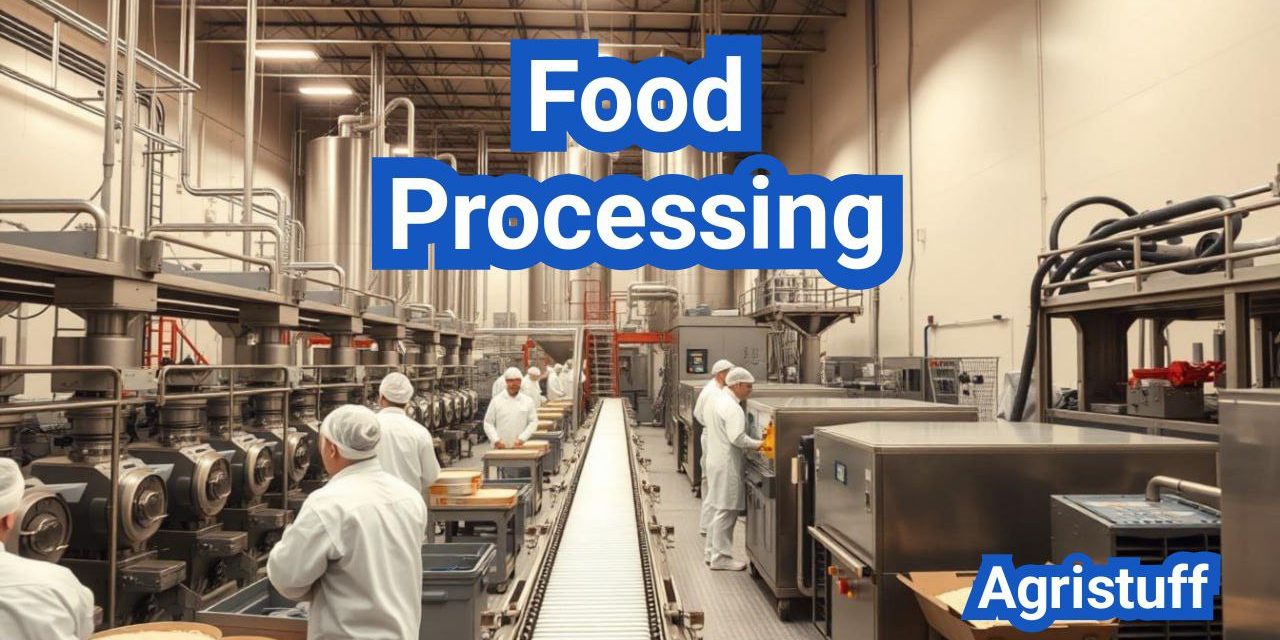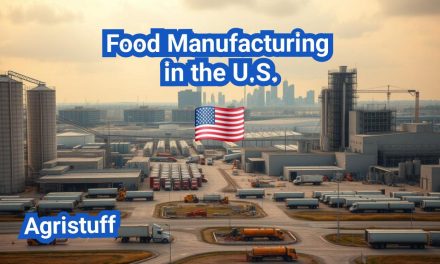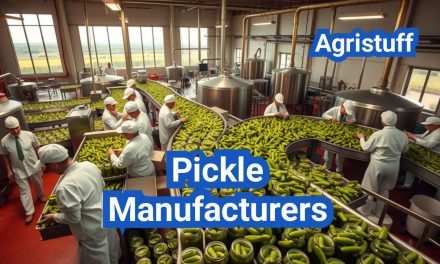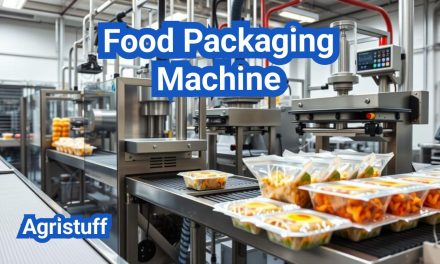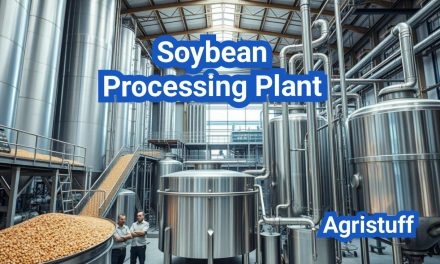The food processing industry is a vital component of the U.S. economy, with annual sales exceeding $1 trillion. At its core, food processing involves transforming raw ingredients into consumable products, making it a crucial step in the food supply chain.
The significance of food manufacturing lies in its ability to provide a wide range of products to consumers, from canned goods to frozen meals. The U.S. food industry relies heavily on various processing methods to ensure the quality and safety of these products.
Key Takeaways
- The U.S. food industry is a significant sector with over $1 trillion in annual sales.
- Food processing involves transforming raw ingredients into consumable products.
- The industry relies on various processing methods to ensure product quality and safety.
- Food manufacturing provides a wide range of products to consumers.
- The core methods used by U.S. plants are crucial to the food supply chain.
What is Food Processing: Definition and Importance
At its core, food processing involves a series of techniques and technologies applied to raw materials to create edible and safe food products. This definition encompasses a broad range of activities, from simple preservation techniques to complex manufacturing processes that transform raw ingredients into consumable goods.
Core Principles of Modern Food Processing
Modern food processing is guided by several core principles, including the need to ensure food safety, maintain nutritional value, and enhance the sensory qualities of food products. Technological advancements play a crucial role in achieving these goals, with innovations in processing techniques, packaging, and storage contributing to the efficiency and effectiveness of food processing operations.
The importance of food processing cannot be overstated, as it directly impacts the availability, affordability, and quality of food. By applying various processing techniques, manufacturers can extend the shelf life of perishable products, reduce food waste, and provide consumers with a wider variety of food choices throughout the year.
Evolution of the U.S. Food Processing Industry
The U.S. food processing industry has undergone significant evolution over the years, driven by changing consumer preferences, advances in technology, and shifts in the global market landscape. Historically, food processing was primarily focused on basic preservation methods such as canning, smoking, and salting. However, the industry has since expanded to incorporate a wide range of sophisticated processing techniques and technologies.
Technological innovations have been a key driver of this evolution, enabling processors to improve efficiency, reduce costs, and enhance product quality. For instance, the adoption of automation and robotics in food processing plants has streamlined operations and increased productivity.
Economic Impact and Market Size
The food processing industry is a significant contributor to the U.S. economy, generating substantial revenue and employment opportunities. According to industry reports, the market size of the U.S. food processing sector is considerable, with a diverse range of businesses operating within the industry, from large multinational corporations to small, specialized processors.
The economic impact of food processing extends beyond the industry itself, influencing related sectors such as agriculture, packaging, and distribution. As the demand for processed foods continues to evolve, driven by changing consumer preferences and demographic trends, the industry is poised for further growth and development.
The Science Behind Food Processing Methods

Food processing methods are rooted in various scientific disciplines, including chemistry, microbiology, and engineering. Understanding these underlying principles is crucial for developing efficient and safe food processing techniques.
Food Chemistry Fundamentals
Food chemistry plays a vital role in food processing. It involves understanding the chemical composition of food and how different processing methods affect its nutritional value, texture, and flavor. Key aspects of food chemistry include the study of carbohydrates, proteins, and lipids, as well as the role of water in food systems.
The chemical reactions that occur during processing, such as Maillard browning, can significantly impact the quality of the final product. For instance, controlling the rate of these reactions can help achieve the desired flavor and color in baked goods.
| Chemical Component | Role in Food | Processing Impact |
|---|---|---|
| Carbohydrates | Provide structure and energy | Can be broken down by heat or enzymes |
| Proteins | Contribute to texture and nutrition | Can be denatured by heat or pH changes |
| Lipids | Enhance flavor and texture | Can become rancid if not properly stored |
Microbiology in Food Safety
Microbiology is critical in ensuring food safety. Understanding the growth and control of microorganisms is essential for preventing foodborne illnesses. Key microbiological considerations include the identification of pathogens, the impact of processing on microbial load, and the implementation of effective sanitation practices.
Techniques such as pasteurization and sterilization are used to reduce microbial contamination. For example, pasteurization involves heating food to a high temperature for a short period to kill harmful bacteria without significantly affecting the food’s nutritional value.
Engineering Principles Applied to Food Manufacturing
Engineering principles are applied in food manufacturing to optimize processing efficiency and product quality. This includes the design of processing equipment, the layout of production facilities, and the implementation of automation technologies.
Key engineering considerations include mass and energy balances, process control systems, and the selection of appropriate materials for equipment construction. For instance, understanding the principles of fluid dynamics is crucial for designing efficient piping systems in food processing plants.
By integrating knowledge from food chemistry, microbiology, and engineering, food manufacturers can develop innovative processing methods that enhance product quality and safety while reducing production costs.
Primary Food Processing Methods in U.S. Plants
The foundation of food production in U.S. plants lies in several primary processing methods that ensure food safety and quality. These fundamental techniques are crucial for transforming raw ingredients into consumable products that meet consumer expectations and regulatory standards.
Cleaning and Sorting Technologies
Cleaning and sorting are initial steps in food processing that significantly impact the quality of the final product. Cleaning technologies involve removing dirt, debris, and contaminants from raw materials. This is achieved through various methods, including:
- Air aspiration to remove lightweight debris
- Water washing to clean fruits and vegetables
- Mechanical brushing to remove dirt and contaminants
Sorting technologies categorize raw materials based on size, color, and quality. Advanced sorting systems use:
- Optical scanners to detect defects or foreign objects
- Color sorting to ensure uniformity
- Size grading to categorize products by dimension
Size Reduction: Milling, Grinding, and Chopping
Size reduction is a critical process in food manufacturing, involving techniques such as milling, grinding, and chopping to transform raw materials into desired particle sizes. Milling is used for grains and cereals, while grinding is applied to various products, including spices and nuts. Chopping is commonly used for fruits and vegetables.
These size reduction methods are essential for:
- Enhancing texture and uniformity
- Improving mixability and blendability
- Facilitating further processing steps
Mixing and Forming Operations
Mixing and forming are vital operations in food processing that ensure uniformity and create desired product shapes. Mixing involves combining ingredients in precise proportions, while forming shapes the mixed product into its final form.
These operations are crucial for:
- Ensuring consistent product quality
- Creating diverse product ranges
- Enhancing product appeal and convenience
Thermal Processing Techniques and Equipment

In the realm of food processing, thermal techniques play a pivotal role in product transformation. Thermal processing is critical for ensuring food safety, extending shelf life, and enhancing product quality. Various thermal processing methods are employed in U.S. food plants, each tailored to specific product requirements.
Pasteurization Standards for Dairy and Juices
Pasteurization is a widely used thermal process that involves heating liquids to a high temperature for a specific period, followed by rapid cooling. This process is crucial for eliminating pathogenic microorganisms in dairy products and juices. The pasteurization standards for these products are stringent, ensuring consumer safety. For instance, HTST (High-Temperature Short-Time) pasteurization is commonly used, where the product is heated to at least 161°F (72°C) for 15 seconds.
UHT Processing for Extended Shelf Life
Ultra-High Temperature (UHT) processing involves heating products to a very high temperature (usually around 280°F or 138°C) for a short duration, followed by aseptic packaging. This method is particularly effective for extending the shelf life of dairy products and juices without refrigeration. UHT processing ensures the destruction of harmful bacteria while preserving the nutritional and sensory qualities of the product.
Retort Processing for Low-Acid Canned Foods (LACF)
Retort processing is a thermal technique used for sterilizing low-acid canned foods. It involves heating the canned product in a retort (a pressure vessel) to a high temperature, typically above boiling point, to achieve commercial sterility. This process is essential for ensuring the safety of canned foods by eliminating Clostridium botulinum spores, which can be hazardous if not properly controlled.
Blanching Operations for Fruits and Vegetables
Blanching is a pre-treatment process that involves briefly submerging fruits and vegetables in boiling water or steam. This thermal process serves several purposes, including inactivating enzymes that cause spoilage, removing surface dirt, and enhancing product color. Blanching is a critical step before freezing or canning, as it helps preserve the quality and nutritional value of the final product.
Freezing and Cold Processing Systems
In the realm of food preservation, freezing and cold processing stand out as critical techniques. Freezing is a common method for preserving food, with various technologies available to suit different product requirements.
Conventional Freezing Methods
Conventional freezing methods involve the use of cold air to freeze products. This technique is widely used due to its simplicity and cost-effectiveness. However, it may not be suitable for all types of products, especially those requiring quick freezing to preserve quality.
Advantages of Conventional Freezing:
- Cost-effective
- Simple to implement
- Suitable for large quantities
IQF (Individually Quick Frozen) Technology
IQF technology involves freezing individual pieces of food quickly, preventing them from sticking together. This method is particularly useful for products like fruits, vegetables, and seafood.
Benefits of IQF Technology:
- Preserves product quality
- Enhances convenience for consumers
- Allows for easy portion control
Cryogenic Freezing with Liquid Nitrogen
Cryogenic freezing uses liquid nitrogen to freeze products rapidly. This method is ideal for products that require fast freezing to maintain their texture and nutritional value.
| Freezing Method | Freezing Time | Product Quality |
|---|---|---|
| Conventional | Slow | Variable |
| IQF | Quick | High |
| Cryogenic | Very Quick | Excellent |
Cold Chain Management in U.S. Food Distribution
Cold chain management is crucial for maintaining the quality and safety of frozen foods during distribution. It involves controlling temperature and humidity throughout the supply chain.
Key Aspects of Cold Chain Management:
- Temperature control
- Humidity management
- Monitoring and tracking
Dehydration and Drying Processes

Food dehydration, a centuries-old practice, continues to evolve with advancements in technology and processing techniques. Dehydration is a critical method for preserving food, with various techniques used across different products to achieve desired quality and shelf life.
Air Drying Systems for Fruits and Vegetables
Air drying is one of the oldest and most common methods used for dehydrating fruits and vegetables. This process involves circulating hot air around the product to remove moisture. Air drying systems are designed to optimize airflow and temperature control, ensuring efficient dehydration while preserving the product’s nutritional value and texture.
The effectiveness of air drying depends on factors such as temperature, humidity, and airflow rate. Modern air drying systems often incorporate advanced technologies like controlled atmosphere drying and infrared drying to enhance the drying process.
Freeze Drying Technology for Premium Products
Freeze drying, also known as lyophilization, is a dehydration process that involves freezing the product and then reducing the surrounding pressure to allow the frozen water to sublimate directly into vapor. This method is particularly valued for producing high-quality, premium products.
Freeze drying preserves the product’s structure, nutrients, and flavor, making it ideal for applications where quality is paramount. Although it is a more expensive process than other dehydration methods, the superior quality of the final product justifies its use in various food categories.
Spray Drying Applications in Dairy and Flavors
Spray drying is a widely used dehydration technique in the dairy and flavor industries. It involves atomizing a liquid feed into a hot gas stream, instantly evaporating the water content and leaving behind a powder or particulate product.
This method is favored for its ability to produce powders with consistent quality and its suitability for heat-sensitive products. Spray drying is used to manufacture a range of products, from dairy powders to flavorings and instant beverages.
Drum Drying for Cereal and Starch Products
Drum drying is another dehydration technique used primarily for cereals and starch products. It involves applying a thin layer of the product onto the surface of a heated drum, where the water content is rapidly evaporated, leaving a dried product that can be scraped off.
Drum drying is efficient for processing high-viscosity products and is often used for producing pre-cooked cereals and instant starch-based foods. The simplicity and cost-effectiveness of drum drying make it a viable option for various industrial applications.
Non-Thermal Preservation Methods in Modern Plants

Non-thermal preservation methods are revolutionizing the way food is processed, offering alternatives to traditional thermal techniques. These methods are increasingly used to maintain food quality and safety, meeting consumer demands for fresher, more nutritious products.
The adoption of non-thermal preservation techniques is driven by the need to minimize the degradation of food quality that can occur with traditional heat-based processing methods. Techniques such as High-Pressure Processing (HPP), food irradiation, pulsed electric field processing, and ultraviolet (UV) light technology are becoming more prevalent in modern food processing plants.
High-Pressure Processing (HPP) Technology
High-Pressure Processing (HPP) is a non-thermal preservation method that involves subjecting food products to extremely high pressures, typically in the range of 400 to 600 MPa, to inactivate harmful bacteria and extend shelf life. This technique is particularly effective for products like guacamole, salsa, and ready-to-eat meats, where maintaining texture and flavor is crucial.
HPP technology offers several advantages, including the ability to process food at ambient or chilled temperatures, thus preserving the nutritional and sensory qualities of the product. It is also a batch process that can be easily integrated into existing production lines.
Food Irradiation Safety and Applications
Food irradiation involves exposing food to ionizing radiation to kill harmful pathogens and pests. This method is used for a variety of products, including spices, grains, and certain fruits and vegetables. Irradiation can significantly reduce the risk of foodborne illnesses and extend the shelf life of products.
Despite initial concerns about safety, food irradiation is recognized by numerous health and food safety organizations worldwide as a safe and effective method for improving food safety. The process does not significantly affect the nutritional content of food, and when properly applied, it maintains the quality of the product.
Pulsed Electric Field Processing
Pulsed Electric Field (PEF) processing is a technique that involves applying short bursts of high-voltage electricity to food products. This method is effective in inactivating microorganisms and can be used for a variety of liquid and semi-liquid foods, including juices and milk products.
PEF processing offers the advantage of minimal heat generation, thus preserving the sensory and nutritional qualities of the food. It is also a continuous process, making it suitable for high-volume production lines.
Ultraviolet and Pulsed Light Technologies
Ultraviolet (UV) light and pulsed light technologies are used to decontaminate food surfaces and packaging materials. UV light is effective against a wide range of microorganisms and can be used for both liquid and solid foods.
Pulsed light technology involves the use of high-intensity, short-duration pulses of light to achieve decontamination. Both UV and pulsed light technologies are non-thermal and do not affect the nutritional or sensory qualities of the food.
In conclusion, non-thermal preservation methods are playing an increasingly important role in modern food processing. By adopting techniques such as HPP, food irradiation, PEF processing, and UV light technology, food manufacturers can improve product safety and quality while meeting consumer demands for fresher, more nutritious foods.
Fermentation and Bioprocessing Applications

Fermentation has long been a cornerstone in food processing, offering a range of benefits from preservation to flavor enhancement. This traditional method has been employed for centuries to create a diverse array of food products, from dairy and meat to beverages and condiments.
Dairy Fermentation for Yogurt and Cheese
Dairy fermentation is a critical process in the production of yogurt and cheese. Lactic acid bacteria are commonly used to ferment lactose, producing lactic acid and causing the milk to curdle. This process not only preserves the milk but also enhances its flavor and nutritional value. Yogurt, for example, is made by adding bacterial cultures to milk, which ferment the lactose, resulting in a product rich in probiotics.
Meat Fermentation for Sausages and Cured Products
Meat fermentation is used to produce sausages and cured products, such as salami and ham. The fermentation process involves the action of microorganisms, typically lactic acid bacteria, which lower the pH and create an environment that inhibits the growth of pathogenic bacteria. This not only preserves the meat but also contributes to its characteristic flavor and texture.
Precision Fermentation Technologies
Precision fermentation represents a modern advancement in fermentation technology, allowing for the precise control of fermentation conditions to produce specific products. This technology is used to produce a range of food ingredients, including flavors, colors, and nutritional supplements. Precision fermentation enables the production of high-quality, consistent products with reduced waste and energy consumption.
The applications of fermentation and bioprocessing are vast and continue to expand as technology advances. From traditional products like yogurt and cheese to innovative ingredients produced through precision fermentation, this ancient technique remains at the forefront of food processing.
Separation and Extraction Processes

Separation processes, including membrane filtration and centrifugation, play a vital role in modern food processing. These techniques are essential for isolating desired components, improving product quality, and enhancing production efficiency.
Membrane Filtration in Dairy Processing
Membrane filtration is widely used in dairy processing for various applications, including microfiltration, ultrafiltration, and reverse osmosis. This technology helps in removing impurities, concentrating products, and achieving the desired texture and flavor.
- Microfiltration removes bacteria and spores, improving milk safety.
- Ultrafiltration concentrates proteins and other valuable components.
- Reverse osmosis is used for water removal and product concentration.
Centrifugation Applications in Food Processing
Centrifugation is another critical separation technique used in various food processing applications, including separation of liquids, clarification, and classification of particles. Centrifuges are used in the production of juices, oils, and dairy products to separate components based on density differences.
- Centrifugal separators are used to clarify fruit juices.
- Decanter centrifuges are applied in the production of olive oil.
- Separation of cream from milk is achieved using centrifugal separators.
Extraction Methods for Oils, Juices, and Essences
Extraction is a crucial process in the production of oils, juices, and flavor essences. Various extraction methods are employed, including mechanical pressing, solvent extraction, and supercritical fluid extraction, each suited to specific applications and product requirements.
- Mechanical pressing is used for extracting juices from fruits and oils from seeds.
- Solvent extraction is applied for obtaining oils and flavor compounds.
- Supercritical fluid extraction is used for producing high-quality essences and oils.
These separation and extraction processes are fundamental to the food processing industry, enabling the production of a wide range of products with desired characteristics. By leveraging these technologies, manufacturers can improve product quality, reduce production costs, and meet consumer demands for safe and nutritious food products.
Advanced Food Processing Equipment and Automation

The integration of cutting-edge machinery and automation in food processing is enhancing efficiency and product quality. This transformation is driven by the need for increased productivity, reduced labor costs, and improved consistency in food products.
Specialized Processing Machinery
Specialized processing machinery is being designed to handle specific food products and processes. For instance, high-pressure processing (HPP) equipment is used to preserve food without heat, maintaining nutritional value and flavor. Similarly, ultrasonic cleaning systems are employed for delicate products, ensuring thorough cleaning without damage.
Some examples of specialized machinery include:
- Peeling and coring machines for fruits and vegetables
- Grinding and milling equipment for grains and spices
- Forming machines for meat and bakery products
Automation and Robotics in Food Plants
Automation and robotics are being increasingly adopted in food processing plants to improve efficiency and reduce labor costs. Robotic systems are used for tasks such as packaging, palletizing, and inspection, allowing for 24/7 operation and reducing the risk of human error.
Some benefits of automation in food plants include:
- Increased productivity through continuous operation
- Improved product consistency and quality
- Reduced labor costs and improved worker safety
As noted by a food industry expert, “Automation is not just about replacing human labor; it’s about augmenting our capabilities to produce higher quality products more efficiently.” –
John Smith, Food Processing Magazine
Industry 4.0 and Digital Transformation
The food processing industry is embracing Industry 4.0 principles, leveraging digital technologies to drive innovation and efficiency. This includes the use of data analytics, IoT sensors, and cloud computing to optimize production processes and predict maintenance needs.
Some key aspects of Industry 4.0 in food processing include:
| Technology | Application | Benefit |
|---|---|---|
| Data Analytics | Production optimization | Improved efficiency |
| IoT Sensors | Real-time monitoring | Predictive maintenance |
| Cloud Computing | Data storage and analysis | Scalability and flexibility |
Packaging Innovations in U.S. Food Processing

Packaging innovations are revolutionizing the way food is preserved and presented in the U.S. market. The role of packaging in food processing cannot be overstated, as it directly impacts food safety, shelf life, and consumer convenience.
Modified Atmosphere Packaging (MAP) Technology
Modified Atmosphere Packaging (MAP) involves replacing the air in a package with a gas mixture to extend the shelf life of products. This technology is particularly useful for perishable goods such as meats, bakery products, and fresh produce.
The benefits of MAP include reduced spoilage, improved food safety, and the ability to maintain product freshness over longer periods. Major retailers have adopted MAP to offer fresher products to consumers.
Active and Intelligent Packaging Systems
Active packaging interacts with the product to improve its condition, while intelligent packaging provides information about the product’s condition. Examples include oxygen scavengers, antimicrobial packaging, and freshness indicators.
These systems enhance food safety and quality by actively responding to changes in the product or its environment. Intelligent packaging can alert consumers to potential spoilage, reducing food waste.
Retort Packaging for Shelf-Stable Foods
Retort packaging involves heat processing food in a sealed container to achieve sterility and long shelf life. This method is commonly used for canned goods and ready-to-eat meals.
The advantages of retort packaging include extended shelf life, ease of transportation, and minimal need for refrigeration. It’s a popular choice for military rations and emergency food supplies.
Aseptic Processing and Packaging
Aseptic processing involves sterilizing food products and packaging separately before filling and sealing in a sterile environment. This method is used for products like dairy, juices, and soups.
Aseptic packaging offers benefits such as long shelf life without refrigeration, preservation of nutritional quality, and convenience for consumers. It’s widely used in the beverage industry for packaging milk and juice products.
| Packaging Technology | Description | Benefits |
|---|---|---|
| MAP | Replaces air with gas mixture | Extended shelf life, reduced spoilage |
| Active & Intelligent Packaging | Interacts with product or provides information | Enhanced safety, quality monitoring |
| Retort Packaging | Heat processing in sealed containers | Shelf-stable, easy transportation |
| Aseptic Packaging | Sterilizes product and packaging separately | Long shelf life, preserved nutritional quality |
U.S. Food Safety Regulations and Compliance

U.S. food safety regulations are designed to minimize the risk of foodborne illnesses through rigorous safety standards. The food processing industry must comply with a complex set of regulations enforced by various government agencies, primarily the FDA.
FDA FSMA Requirements for Processors
The Food Safety Modernization Act (FSMA) represents a significant shift in food safety regulation, focusing on prevention rather than response. Key requirements include:
- Implementing preventive controls to identify and mitigate hazards
- Conducting regular inspections and monitoring
- Maintaining detailed records of safety protocols and compliance
Preventive Controls are a critical component, requiring processors to identify potential hazards and implement measures to control them.
HACCP vs. Preventive Controls Framework
Historically, HACCP (Hazard Analysis and Critical Control Points) has been used to ensure food safety. However, FSMA introduced the Preventive Controls Framework, which builds upon HACCP principles but is more comprehensive.
The main differences include:
- Broader scope, including both Hazard Analysis and Preventive Controls
- More stringent requirements for supplier verification
- Enhanced record-keeping and documentation
Traceability Rule204 Implementation
The FDA’s Traceability Rule (Rule 204) enhances the ability to track food products throughout the supply chain. Processors must maintain detailed records of key data elements, including:
- Receiving and shipping information
- Transformation and processing details
- Product labeling and packaging information
Food Allergen Controls for the Big9 Allergens
The Big9 allergens, as identified by the FDA, are major contributors to food allergies. Processors must implement controls to prevent cross-contamination, including:
- Segregated storage and handling procedures
- Sanitation protocols to prevent cross-contact
- Clear labeling of allergenic ingredients
By adhering to these regulations and implementing robust safety protocols, U.S. food processors can significantly reduce the risk of foodborne illnesses and ensure compliance with FDA requirements.
Sanitation and Hygiene in Processing Facilities
The importance of rigorous sanitation and hygiene protocols in food processing cannot be overstated, as they are key to preventing foodborne illnesses. Maintaining a clean and sanitary environment is essential for ensuring the safety and quality of food products.
Sanitation Standard Operating Procedures (SSOPs)
Sanitation Standard Operating Procedures (SSOPs) are detailed, written procedures that outline the steps to be taken to ensure the cleanliness and sanitation of food processing facilities. These procedures are critical for preventing contamination and ensuring compliance with regulatory requirements.
Key elements of effective SSOPs include:
- Clear descriptions of cleaning tasks and schedules
- Specifications for cleaning agents and sanitizers
- Training programs for personnel responsible for sanitation
- Record-keeping to document sanitation activities
Clean-in-Place (CIP) Systems Design
Clean-in-Place (CIP) systems are designed to clean and sanitize equipment and pipelines without the need for disassembly, reducing downtime and improving efficiency. Effective CIP system design is crucial for maintaining sanitation standards.
| CIP System Component | Function | Design Consideration |
|---|---|---|
| Pumps and Piping | Deliver cleaning solution | Ensure adequate flow rate and pressure |
| Tanks and Vessels | Hold cleaning solution | Design for easy cleaning and drainage |
| Spray Balls and Nozzles | Distribute cleaning solution | Position for effective coverage |
Environmental Monitoring Programs
Environmental monitoring programs involve regular sampling and testing of the processing environment to detect potential contamination. These programs are essential for identifying and addressing sanitation issues before they impact product safety.
Effective environmental monitoring includes:
- Identification of sampling locations
- Regular sampling schedules
- Testing for relevant pathogens and indicators
- Corrective actions for positive findings
Hygienic Equipment Design Principles
The design of equipment used in food processing facilities plays a critical role in maintaining sanitation and hygiene. Hygienic equipment design principles prioritize ease of cleaning, durability, and compatibility with cleaning agents.
Key principles include:
- Smooth, non-porous surfaces
- Easy disassembly for cleaning
- Avoidance of crevices and dead ends
- Compatibility with cleaning and sanitizing agents
Industry-Specific Processing Applications
The application of processing techniques is highly specialized across various food industries. Different sectors within the food processing industry employ unique methods to achieve desired product qualities, ensuring that the final products meet consumer expectations and regulatory standards.
Meat and Poultry Processing Methods
Meat and poultry processing involves a range of techniques, including slaughtering, deboning, and packaging. Advanced technologies such as automated cutting systems and modified atmosphere packaging are used to enhance efficiency and product safety.
Key Techniques:
- Automated deboning and cutting
- Modified atmosphere packaging
- High-pressure processing for safety enhancement
Dairy Processing Standards and Methods
Dairy processing is critical for producing milk, cheese, yogurt, and other dairy products. Techniques such as pasteurization, ultra-high temperature (UHT) processing, and membrane filtration are employed to ensure product safety and quality.
| Technique | Application | Benefit |
|---|---|---|
| Pasteurization | Milk and dairy products | Pathogen reduction |
| UHT Processing | Milk and cream | Extended shelf life |
| Membrane Filtration | Cheese production | Improved quality and yield |
Fruit and Vegetable Processing Techniques
Fruit and vegetable processing involves cleaning, sorting, peeling, and packaging. Techniques such as blanching and freezing are used to preserve nutritional value and extend shelf life.
Blanching is a critical step that inactivates enzymes, preserving color and texture.
Grain and Cereal Processing Operations
Grain and cereal processing includes milling, grinding, and flaking. Advanced technologies such as precision milling and automated sorting enhance product quality and reduce waste.
- Precision milling for consistent particle size
- Automated sorting for quality control
- Flaking for breakfast cereals and snacks
Nutritional Considerations in Food Processing
The nutritional aspects of food processing are multifaceted, involving various techniques to preserve nutrient content. Food processing can significantly impact the nutritional quality of the final product, making it crucial to balance safety with nutritional value.
Nutrient Retention Strategies
Nutrient retention is a critical aspect of food processing. Techniques such as minimal processing, gentle heat treatment, and reduced water usage can help retain nutrients. For instance, steaming vegetables instead of boiling them helps preserve vitamins and minerals.
Key strategies for nutrient retention include:
- Minimal processing to reduce nutrient loss
- Gentle heat treatment to preserve sensitive vitamins
- Reduced water usage to minimize water-soluble nutrient loss
Fortification and Enrichment Practices
Fortification and enrichment are practices used to enhance the nutritional value of food products. This involves adding micronutrients such as vitamins and minerals to foods during processing. Examples include fortifying cereals with iron and enriching milk with vitamin D.
Fortification practices help address nutritional deficiencies in populations. For example, iodizing salt has significantly reduced iodine deficiency disorders worldwide.
Processing Effects on Bioavailability
Food processing can affect the bioavailability of nutrients. Bioavailability refers to the body’s ability to absorb nutrients from food. Certain processing techniques, such as cooking and grinding, can enhance bioavailability by breaking down cell walls and making nutrients more accessible.
For instance, cooking tomatoes increases the bioavailability of lycopene, an antioxidant. Conversely, over-processing can lead to a loss of nutrients, reducing their bioavailability.
Balancing Safety and Nutritional Quality
Balancing food safety with nutritional quality is a significant challenge in food processing. While processing techniques are essential for ensuring food safety, they can sometimes compromise nutritional value. Techniques such as pasteurization are crucial for safety but can affect certain nutrients.
To address this, manufacturers are adopting technologies that minimize nutrient loss while ensuring safety. For example, high-pressure processing (HPP) can inactivate pathogens without significantly affecting nutritional content.
The Future of Food Processing in the U.S.
The U.S. food processing industry is on the cusp of a new era, driven by technological advancements and shifting consumer preferences. As explored in this article, various processing methods, from thermal processing to non-thermal preservation, have transformed the way food is manufactured and distributed.
The future of food processing will be shaped by innovations in automation, Industry 4.0, and digital transformation. These advancements will enhance efficiency, safety, and product quality. The industry will also need to adapt to changing consumer demands for healthier, more sustainable products.
U.S. food industry trends indicate a growing focus on nutrient retention, fortification, and environmentally friendly packaging. As the industry continues to evolve, it is likely that we will see increased adoption of precision fermentation, high-pressure processing, and other emerging technologies.
The future of food processing in the U.S. will be characterized by a blend of tradition and innovation, with a focus on meeting the needs of a rapidly changing market while ensuring food safety and quality.
FAQ
What is food processing, and why is it important?
Food processing refers to the transformation of raw ingredients into consumable products through various physical, chemical, or biological methods. It is crucial for ensuring food safety, extending shelf life, and enhancing nutritional value.
What are the primary methods used in food processing plants?
Primary methods include cleaning, size reduction, mixing, thermal processing, freezing, dehydration, and non-thermal preservation techniques like HPP and food irradiation.
What is the significance of thermal processing in food manufacturing?
Thermal processing techniques, such as pasteurization, UHT processing, and retort processing, are used to kill pathogens, extend shelf life, and enhance food safety.
How does freezing preserve food, and what are the different freezing methods?
Freezing preserves food by inhibiting microbial growth and slowing down chemical reactions. Methods include conventional freezing, IQF, and cryogenic freezing.
What is non-thermal preservation, and what methods are used?
Non-thermal preservation involves using techniques like HPP, food irradiation, and pulsed electric field processing to preserve food without heat.
How does fermentation contribute to food processing?
Fermentation is used to produce a variety of products, including yogurt, cheese, sausages, and cured meats, by harnessing microbial activity.
What is the role of packaging in food processing?
Packaging plays a critical role in maintaining food safety, preventing contamination, and extending shelf life through technologies like MAP, active and intelligent packaging, and aseptic packaging.
What are the key U.S. food safety regulations that processors must comply with?
Processors must comply with FDA FSMA requirements, HACCP, traceability rule 204, and food allergen controls for the Big9 allergens.
Why is sanitation and hygiene crucial in food processing facilities?
Sanitation and hygiene practices are essential for preventing contamination, ensuring food safety, and maintaining a clean environment through SSOPs, CIP systems, and environmental monitoring.
How does food processing impact nutritional value?
Food processing can affect nutritional value through nutrient retention strategies, fortification, and enrichment practices, as well as processing effects on bioavailability.
What is the future outlook for the U.S. food processing industry?
The industry is expected to continue evolving with advancements in technology, automation, and innovative processing methods, driving growth and improving food safety and quality.
Conclusion of: Food Processing Explained
What “food processing” means and why it matters in the U.S.
In the United States, food processing refers to the set of industrial operations that transform raw agricultural commodities—grains, milk, meat, fruit, vegetables, oils—into safe, stable, convenient, and consistently high-quality foods. From simple washing and cutting to complex thermal sterilization, modern food processing improves shelf life, enables national distribution, and supports nutrition programs that rely on standardized products. At its best, food processing reduces waste and protects consumers from pathogens and spoilage, while meeting regulatory standards that ensure safety at scale. Institute of Food Technologists overview
Who regulates food processing in the U.S. (and how)
Most U.S. food processing facilities fall under the Food and Drug Administration’s Preventive Controls for Human Food rule (21 CFR Part 117), which requires a written food safety plan based on hazard analysis and risk-based preventive controls; meat, poultry, and certain egg products are overseen by USDA’s FSIS under HACCP mandates. Together, these systems put process control at the heart of food processing, shifting from reactive inspection to proactive prevention. FDA Preventive Controls Final Rule
HACCP and preventive controls: the backbone of process safety
Every food processing line is expected to identify hazards and build controls where they matter most. USDA’s 9 CFR Part 417 requires meat and poultry plants to operate under HACCP—defining critical control points, acceptable limits, monitoring, corrective actions, verification, and robust records. FDA’s preventive controls framework parallels these principles for other food processing sectors, ensuring that biological, chemical, and physical hazards are prevented or minimized before products ship. USDA FSIS HACCP regulations
Primary vs. secondary food processing operations
Primary food processing converts raw materials into food ingredients—think milling wheat into flour or rendering oilseeds into edible oils. Secondary food processing turns those ingredients into finished products—pasta, bread, yogurts, canned soups—often integrating multiple unit operations (mixing, heating, cooling, drying, packaging). Both levels of food processing rely on validated steps to control hazards while preserving taste and nutrition. IFT on processing methods
Thermal processing: pasteurization, sterilization, and retorting
Thermal methods are the most widely used food processing tools to destroy pathogens and spoilage organisms. “Low-acid canned foods” (pH > 4.6, aw > 0.85) must achieve commercial sterility via validated heat processes (e.g., retorts, continuous rotary sterilizers) and are tightly regulated to ensure shelf stability at ambient temperatures. Acidified foods have separate controls tailored to pH and heat. In U.S. food processing, these categories determine process design, monitoring, and recordkeeping. FDA LACF & acidified foods guidance
Milk pasteurization: a foundational case study
Dairy food processing illustrates how time-temperature parameters drive safety outcomes. Federal regulation mandates pasteurization for milk in final package form intended for direct human consumption (e.g., 161°F/72°C for 15 seconds for HTST), with adjustments for high-fat or sweetened products. These validated conditions form a core control step in dairy food processing, protecting consumers against pathogens such as Listeria, Salmonella, and Campylobacter. 21 CFR §1240.61 pasteurization
Chilling and freezing: locking in safety and quality
Rapid cooling and freezing are essential food processing steps that slow or halt microbial growth and enzymatic spoilage. Individually quick frozen (IQF) fruits and vegetables, for example, are processed so each piece freezes separately, aiding portion control and quality. Across U.S. food processing, validated freezing and cold storage protocols support both safety and product integrity from plant to plate. USDA FSIS: Freezing & Food Safety
Drying and dehydration: from powders to jerky
Dehydration is a classic food processing method that reduces water activity to inhibit microbial growth, producing stable powders (spray-dried milk, coffee), flakes (drum-dried potato), and shelf-stable snacks (fruit leathers, jerky). Industrial dryers must balance heat, mass transfer, flavor, and nutrient retention—key trade-offs in modern U.S. food processing. IFT perspective on processing
Fermentation and culturing: harnessing microbes for safety and flavor
Fermented foods—yogurt, cheese, kimchi, sauerkraut, salami—use controlled microbial activity as a food processing step to acidify, preserve, and create characteristic flavors. In regulated U.S. food processing environments, fermentation parameters (starter culture, temperature, time, salt, pH) are specified in HACCP or preventive control plans and validated to ensure predictable safety outcomes. USDA FSIS HACCP guidance hub
Non-thermal technologies: high-pressure processing (HPP) and more
To retain fresh-like attributes, many food processing operations apply non-thermal technologies. High-pressure processing (HPP) inactivates microbes using isostatic pressure (often 400–600 MPa) in sealed packages, extending shelf life with minimal heat. FDA’s guidance addresses validation, packaging integrity, and process controls—now routine considerations in U.S. food processing for juices, dips, deli items, and RTE meals. FDA guidance (Preventive Controls, Ch. 4: Process Controls incl. HPP)
Separation and concentration: membranes, centrifuges, and more
Membrane filtration (micro-, ultra-, nano-filtration and reverse osmosis) is a quiet workhorse of U.S. food processing, concentrating milk proteins, clarifying juices, and reducing salts with fine control and lower thermal loads. In dairy food processing, ultrafiltration boosts protein levels for Greek-style yogurts and functional ingredients while helping plants meet product specs efficiently. USDA ARS ultrafiltration fact sheet
Food irradiation: a validated lethality and disinfestation option
Irradiation is another science-based food processing tool used to reduce pathogens (e.g., Salmonella on spices) and control insects in certain foods without significantly raising temperature. It’s carefully regulated for dose, food type, and labeling, and can complement other food processing controls to improve safety and reduce waste. FDA: Food Irradiation—What You Need to Know
Packaging and shelf-life extension: from aseptic to MAP
Packaging is integral to food processing because it protects the microbial and sensory status that processing achieves. Aseptic systems sterilize product and package separately before sterile fill, while reduced-oxygen and modified atmosphere packaging (MAP) slow spoilage and oxidation. Meat and poultry food processing operations apply MAP within FSIS guidance to maintain safety and quality. FSIS: Modified Atmosphere Packaging basics
Allergen control is non-negotiable
Allergen cross-contact is a leading preventive control in U.S. food processing. The FDA recognizes nine major allergens (milk, eggs, fish, crustacean shellfish, tree nuts, peanuts, wheat, soybeans, and sesame), with strict labeling and program expectations. Effective food processing plants implement dedicated changeovers, validated cleaning, label controls, and supplier verification to keep consumers safe. FDA: Food Allergens (Big 9)
Sanitation and SSOPs: the daily discipline behind safe plants
Validated sanitation keeps food processing environments in control between runs. USDA’s sanitation performance standards (9 CFR 416) and FDA cGMPs require written procedures, trained personnel, and documented verification. From equipment disassembly to ATP swabs and environmental Listeria testing, sanitation underpins every other food processing control. 9 CFR Part 416 sanitation standards
Traceability and records: Rule 204 raises the bar
The FDA’s Food Traceability Final Rule (FSMA Rule 204) adds recordkeeping for certain high-risk foods—from critical tracking events to key data elements—so outbreaks can be contained faster. Digital lot codes, robust receiving/shipping documentation, and interoperable systems are becoming standard parts of U.S. food processing operations, streamlining recalls and protecting brands. FDA: Food Traceability Final Rule
Quality control and microbiological testing
Beyond safety, food processing plants monitor quality with sensory checks, chemistry, and microbiology. FDA’s Bacteriological Analytical Manual (BAM) guides standardized methods (e.g., aerobic plate count, Salmonella detection) used by industry and labs for verification and release decisions. Consistent test methods help U.S. food processing maintain trust and compliance. FDA BAM (methods hub)
Energy, water, and pollution prevention in processing plants
Modern food processing also optimizes resource use. EPA encourages source reduction, energy efficiency, and smarter water management, providing sector-specific data and techniques to reduce releases and operating costs. Many U.S. food processing facilities adopt heat recovery, efficient refrigeration, and water reuse strategies to meet sustainability goals. EPA: Food & Beverage sector (TRI)
Worker safety in processing environments
Safe food processing protects workers as well as consumers. OSHA highlights hazards from moving machinery, sanitation shifts, and chemicals (e.g., ammonia refrigeration), stressing lockout/tagout, guarding, and hazard communication. Strong safety systems keep U.S. food processing plants compliant and resilient, reducing injuries and downtime. OSHA: Food Manufacturing
How regulations shape everyday process choices
In practice, U.S. food processing teams design their unit operations and critical limits around the specific product category: low-acid canned foods follow 21 CFR 113; acidified foods follow 21 CFR 114; dairy pasteurization follows 21 CFR 1240.61; and most other foods fall under 21 CFR 117 for preventive controls. This rule-driven architecture keeps food processing decisions evidence-based and auditable. 21 CFR 113 (LACF) at eCFR
Examples you see every day
IQF vegetables blanched then fast-frozen, shelf-stable canned beans retorted to commercial sterility, HTST-pasteurized milk, vacuum-packed ready-to-eat meats, and pressure-treated fresh salsas—all reflect how U.S. food processing aligns technology with product risk. Each example blends validated steps with tight packaging to deliver quality at scale—a hallmark of efficient food processing. USDA AMS: Grades & Standards (processed foods)
How processors validate and document their methods
Validation demonstrates that a food processing step achieves its intended control (e.g., a 5-log pathogen reduction), while verification shows it’s executed correctly day-to-day (calibrations, records, product testing). Regulatory frameworks expect scientific justification plus ongoing verification—core to robust U.S. food processing systems and customer confidence. FSIS: HACCP Systems Validation
Innovation trend: cleaner labels with strong safety
Consumers increasingly want minimal labels, and U.S. food processing meets that demand with process-driven controls: HPP in lieu of thermal, aseptic systems for dairy alternatives, smarter MAP, and careful formulation. The aim is the same—safe, stable food with fewer additives—achieved by engineering and verification embedded in modern food processing. FDA guidance on process controls
Buying or selling into U.S. markets: why process literacy pays
Suppliers to U.S. food processing plants benefit from understanding process categories (e.g., LACF vs. acidified), allergen programs, packaging compatibility, and traceability data needs. Clear documentation and validated specs streamline approvals and audits—turning technical compliance into a commercial advantage across the food processing supply chain. 21 CFR 114 (Acidified Foods)
Final thought
Whether it’s heat, cold, pressure, membranes, or packaging atmospheres, every method in U.S. food processing exists to deliver safe, reliable food at scale. The best plants integrate science-based controls, detailed records, and continuous improvement—so consumers get quality they can trust and brands get resilience in a strict but innovation-friendly regulatory environment.
Sources & References
- FDA – FSMA Final Rule: Preventive Controls for Human Food
- 21 CFR Part 117 – cGMPs & Preventive Controls (eCFR)
- 9 CFR Part 417 – USDA FSIS HACCP (eCFR)
- FDA – LACF & Acidified Foods Guidance
- 21 CFR §1240.61 – Mandatory Milk Pasteurization
- USDA FSIS – Freezing & Food Safety
- FDA – Food Irradiation
- 9 CFR Part 416 – Sanitation Performance Standards
- FDA – Bacteriological Analytical Manual (BAM)
- USDA AMS – Grades & Standards
- 21 CFR 113 – Thermally Processed Low-Acid Foods (eCFR)
- 21 CFR 114 – Acidified Foods (eCFR)

